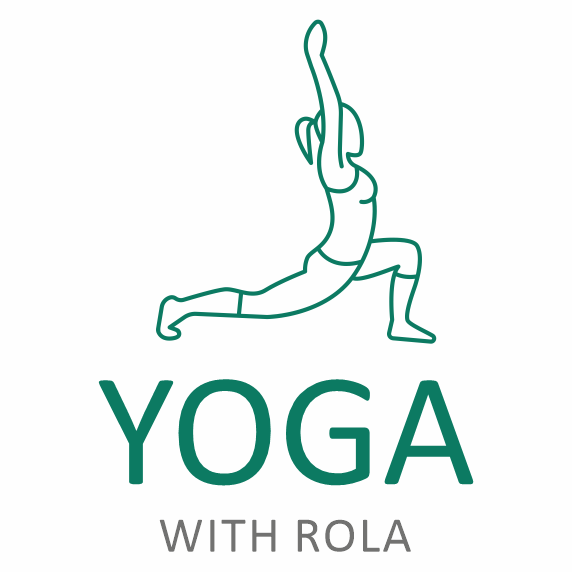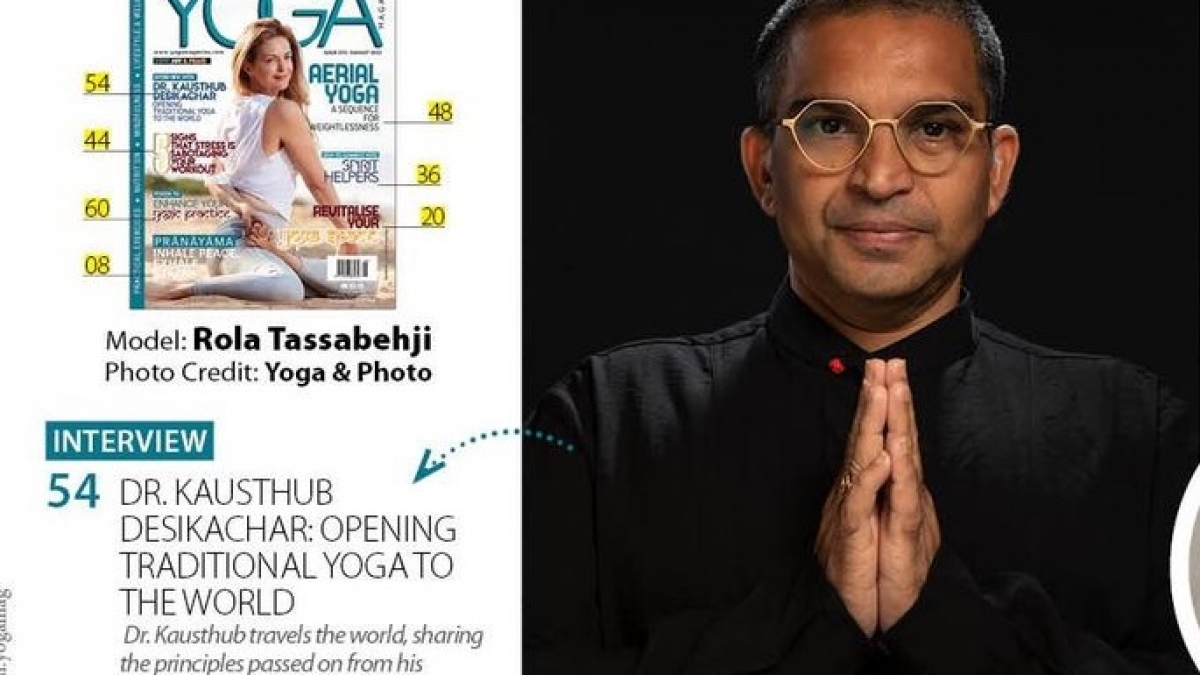In an exclusive conversation with the current lineage holder of the classical Viniyoga tradition of T Krishnamacharya and T.K.V. Desikachar, Dr. Kausthub Desikachar explains the
challenges, and opportunities, for keeping the tradition alive in modern times.
Following the footsteps of his grandfather T. Krishnamacharya, considered the “father of modern day Yoga” and his father, the influential T.K.V. Desikachar, Dr. Kausthub chose to dedicate his life to teaching Yoga and Yoga Therapy. He travels the world, sharing the
principles passed on from his ancestors and dating back 1200 years.
His mission is to open the ancient practice to people from different healing system and modalities to promote physical, emotional, social and spiritual health. In this two-part series, Yoga Magazine explores his Yoga journey, how the present reality is influencing traditional Yoga as practiced in India for thousands of years, and the future of the lineage he
represents.
Tell us a little about when you started your Yoga journey
I call myself the last dinosaur who is still holding the fort of traditional authentic Yoga, but it did not start out that way. I was a kind of a prodigal son, the rebel, and the last in my family to enter Yoga. Then my father started his school, he began a children’s Yoga class, which included children of his students. At some point, he wanted the three of us — me, my older brother and younger sister— to join. I initially refused while they attended these classes.
This was in the 1980’s, when there was not much TV or entertainment. So, I started feeling alone in the house while my brother and sister would come back saying how fun it was. To be honest, that was my motivation to join Yoga class when I was around 9 years old. I did not want to miss out on the fun. As more students joined, my father divided the group into smaller ones
and had the more advanced students teach the younger. By the time I was 13 years old, I was teaching and continued until I was 17, when I went to university in North India.
But throughout these years, my father never forced me to do Yoga or attend the classes. I chose to go, and that is the beauty of it. Even later in my 20’s when I wanted to commit all my time to Yoga, he said don’t be a Yoga teacher because it is not easy. And he was right.
What did you study in university?
I left Chennai from 1992 till July 1997 to study Economics and Management at a university that was one of the best in India but also the furthest from home. (In a way) I wanted to run
away from Yoga and my family.
University was a fascinating experience. While I intended to study Economics and Management, I discovered I was more interested in Health and Healing Studies. Eventually, a professor teaching Health Science asked me: why do you want to go into the health and wellness domain at the university when your father is the greatest healer? While trying to run
away, here was a professor who I admired so much telling me you have the best teacher back home.
So, after my dual master’s degree from the renowned Birla Institute of Technology & Sciences, Pilani, I came back and committed to becoming a full-time student and teacher of Yoga. Sometimes you don’t value the things that are so close. Later in 2011, I concluded my doctoral studies from the Psychology Department at the University of Madras, where my topic of research was “Effect of Individualised Yoga Training on Quality of Life.”
What was this formal Yoga training like?
This was the time, in 1997, when the school had a three-year training program to learn, among other things, about Asanas, Autras, and Indian tradition and culture because Yoga is so much a part of India. There was a whole set of topics as part of this holistic training. It was never based on Asanas only.
Perhaps this is one of the most fundamental differences from Yoga training today, where the focus is on the physical discipline. Most often, modern Yoga in the West is treated as a sport, or a form of physical stretching, rather than a spiritual practice. My Yoga Therapy training was also very different from some of the modern training. Ask yourself, when Yoga was started more than 2000 years ago, did modern medicine exist?
Yogis understood the human body within their own framework and evolved tools based on that understanding. Developed through careful and constant observation and extraordinary intuition, the tools of Yoga use more than just the musculoskeletal framework of the body. Yoga’s tools involve all aspects of our being, taking into account our breathing patterns,
emotions and intellect. Not to say that modern medicine does not have its place, but we can’t understand Yoga through modern medicine. This is one of the key reasons to search for Yoga traditions that base their teachings on exhaustive understanding of the subtle human system.
Tell us about your Krishnamacharya Healing and Yoga Foundation in Chennai
My father and I started the Krishnamacharya Healing and Yoga Foundation in India in 2006 because he wanted to have an umbrella organization to link all the teachers, therapists and students of our tradition. In recent years, the Viniyoga® tradition has been eagerly sought after by many yoga
teachers and students as it complements the principles of traditional Asian medicine. So, in
2019, we started an affiliate school in Singapore. Many Asian students can understand
traditional Yoga more easily because (some form of) it exists in their own culture and
tradition. While mostly gentle, it is also a great way to keep the body fit and cultivate a healthy mind. As an affiliate school of KHYF, Viniyoga® Singapore offers a comprehensive suite of online and on-site Yoga and meditation classes in Singapore as well as Yoga teacher training and Yoga therapy training following the authentic Viniyoga® tradition.
What is Viniyoga style of Yoga?
Our tradition is 1200 years old. We can trace Krishnamacharya’s spiritual lineage to the famous ninth century South Indian sage Nathamuni. Very few traditions go that far back.
The classical Viniyoga tradition includes several unique features, such as self-empowerment, where students are responsible for their individual healing and personal development; spiritual development, where students embark on a path of self-transformation; therapy, with a systematic approach to achieving therapeutic goals; and philosophy, for students to understand the deep-rooted classical teachings of Viniyoga which are complementary to modern medical approaches.
Viniyoga is also based on the teacher-student model, where an experienced teacher works individually with each student. It takes into account the student’s health, age and any
ailments he or she may have, to devise a well-rounded and customised Yoga program.
This adaptability also extends to the times. We can’t be out of touch with developments ofthe modern era. We have among our patrons, medical doctors, Ayurveda doctors as well as
Buddhist monks. We are therefore integrating all aspects of society and adapting while still being respectful to core teaching.
Expand on the spirituality of your Yoga tradition
According to Yoga, we are made of two parts, the material part which includes body, mind and senses, and the non-material, which includes our spirit and Īśvara, inside our spirit.
Yoga is a spiritual discipline, and one must have a spiritual orientation to benefit most from Yoga’s tools. This spirituality comes in the form of feeling a deep connection to oneself and
one’s own potential along with a desire to fully express it. It also involves a connection to others and to the environment we are living in.
If Yoga practice is completely devoid of a spiritual connection, then it becomes more like a physical fitness routine. There are benefits, but not as pronounced.
Your grandfather’s famous students Iyengar and Pattabhi Jois progressed to develop their own Yoga styles. Why do you think practices like Ashtanga and Iyengar have become so popular in the West?
I really don’t know why that is and I can only speculate. And I may be totally wrong here in my speculation. I feel that in the West, it is easier for people, especially the common man, to
understand the materialistic, or relating to body. Perhaps that is one of the reasons they can relate to styles of Yoga such as Ashtanga. A second reason is that styles like Iyengar, Ashtanga and even Bikram Yoga offer a standardized and structured formula to follow.
I think modern people (in general) like structure. Non-material domains like the energetic can be confusing compared to a more sequential body approach. A third reason is that when you learn a physical practice, it becomes like a sport and sport is very popular in the West.
How do you see the future of Yoga? Since you are traveling again do you see new trends post COVID-19 and in the age of climate change?
I am seeing many people realizing that physical practices alone are leading them nowhere. There is an unconscious surge for something different — much deeper and spiritual. So there appears to be an undercurrent of people fascinated by traditional Yoga. More people are starting to explore the non-physical. These changes are happening not only in the West
but also in India where these physical forms or Asanas, came from.
So, I see change but I am not sure if climate change or COVID-19 have affected this surge. I recently checked my files and found that, in the last year alone, I had more than 600 one-to- one classes, mostly virtual, so there is certainly a greater awareness and appreciation for going back to authentic traditional Yoga.
There are many definitions of Yoga. What is your favorite?
The one that is closest to my heart is defined by my father, TKV Desikachar. He defined Yoga as a relationship, and I feel this is the best definition possible especially in today’s times. First, Yoga helps us to have a relationship with ourselves — with our body, with our breathing, with our mind, with our ego and with our potentials.
A second domain where Yoga helps us is in the inter-personal domain — our relationship with other people, relationship with members of our family, in our working environment, in
our employment, in our society.
Now we have a good relationship with ourselves and with others, Thirdly, Yoga also helps us to transcend these into the trans-personal domain — the domain of spirituality, the domain of the divine. Thus, Yoga can also help us have a good relationship with the divine. My father simply put it as Yoga is a relationship. This is consistent with the message of the
root meaning of yoga – yuj: to link, to connect, which is the basis of every relationship.
How do you define Yoga Therapy?
My father and I defined Yoga Therapy as follows: “Individualized Yoga Therapy is a self-empowering process, where the care-seeker, with the help of the Yoga therapist, implements a personalized and evolving Yoga practice, that not only addresses the illness in a multi-dimensional manner, but also aims to alleviate his/her suffering in a progressive,
non-invasive and complementary manner.”
Currently, we are seeing more Yoga Therapy training programs with different approaches, and some organizations trying to create accreditation standards around this discipline. In this regard, I don’t believe in following the modern Yoga bodies or international organizations as I don’t think they are legitimate enough to govern Yoga and only serve as expensive registry.
One has to be aware in finding a qualified Yoga Therapist through traditions that are strong in Yoga Therapy and have a long history of its practice.
What are your future plans for Viniyoga?f
In the future, we are opening affiliate schools in Brussels, and perhaps in New Zealand and Spain. The foundation in Singapore is playing a big role in taking our tradition internationally.
Our goal is not to become a Yoga empire or become the most popular Yoga school in the world but to be the highest quality Yoga providers and trainers — sustaining this tradition for the next 1200 years. We have endured 1200 years and our goal is to endure further. I am also publishing new books, including an English translation of the Sutras commentary by my grandfather.
How does your day usually start and what kind of yoga do you practice?
My day usually starts by waking up in the morning, at 4:00 or 4:30 am with a Yoga practice that includes Āsana, Prāṇāyāma, Mudrā, and Mantra-japa at the end. Typically about one or one hour and 15 minutes. Then, I begin my day teaching but try to incorporate short Prāṇāyāma practices during the day.
I deal with a lot of heavy and intense situations in Yoga Therapy and need to cleanse myself, to recharge as a care provider. And one of the best and most accessible tools for this is Prāṇāyāma. It can be as simple as alternate nostril breathing (Nāḍiśodhana Prāṇāyāma) and can be done anywhere, including ten minutes in the office.
In this regard, it is important to remember that that Yoga teachers are human and we must not look and project Yoga teachers as perfect, as if on a pedestal.
From all the Yoga classic books you have read, which one do you go back to most often and is still relevant today?
I consider the Yogasūtra’s of Patañjali the most important references on Yoga. They have several layers of meaning and the language is highly symbolic, but they remain very relevant
even if thousands of years old.
Krishnamacharya was a master of the Sūtras and he wanted his son to grasp the depth of meaning hidden in the text and taught him the text nine times in three decades, always revealing more layers and deeper understanding. My father later wrote “The Heart of Yoga” in order to present the principles of Yoga in a way that could be understood by everybody. The book remains a classic and one of the best books on Yoga available today.
Do you feel optimistic about the future of traditional Yoga? Or is it at risk of disappearing in the face of western yoga?
I used to have the feeling that authentic Yoga is in danger of being Westernized and disappearing, but I have come to realize that Yoga does not need saving. Yoga saves us. I am too small to carry that burden and can only do my best. In the end, I am a Yoga teacher not Yoga police. It is not my or anyone’s responsibility, and we need to be open to change.
We have to deal with whatever happens as Yoga will continue to evolve, and we need to make the best of that situation. If we look the history of Yoga, it has survived many years and will continue to evolve while keeping the tradition alive.
How do you spread your ideas?
I have been fortunate to not travel during my younger student years because my teacher lived in my house. My duty now is to travel so that Karma is balanced. I also use modern tools like technology and social media to spread the learning. These platforms can be useful for spreading ideas and education.
Any last word for committed Yogis who follow Krishnamacharya tradition or plan to go on teacher training based on this tradition?
Keep an open heart. This openness means avoiding judgment and dogma. Yoga students and teachers alike can become fanatical and judgmental to those practicing other forms of
Yoga.



Add a Comment